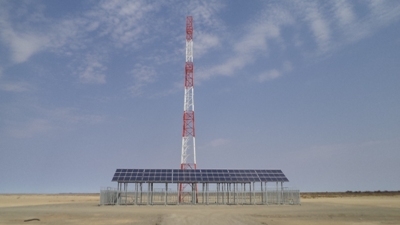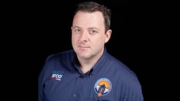
Milestone communications technology in place for 1 600 km/h Land Speed Record attempt
This month marked a significant milestone in the development of The BLOODHOUND Project, the global education initiative focused around a 1000 mph (1 600 km/h) Land Speed Record attempt: the completion of the desert towers which will beam video and data from the car to the outside world.
The product of years of research by BLOODHOUND and its network provider, MTN, the four masts erected at Hakskeenpan in the Northern Cape, are vital to the project’s success. In 2015 – 16, when the team attempts, initially, to break the existing Land Speed Record (1 227.93 km/h set by Thrust SSC in 1997) and then push on to an unprecedented 1 600 km/h, the world will be watching. Video and data will be streamed live and shared with audiences in 220 countries, supporting what will become one of the biggest news stories on the planet.
“Getting live data and images at supersonic speeds off the car is not only extremely tricky, it is pivotal to our ambitions,” says Conor La Grue, Commercial and Product Sponsorship Lead of the BLOODHOUND SSC Project. “From the very beginning we have shared our story as we have gone along. It is fundamental to our education goal. If we can’t show what we’re doing in the desert, and involve our global audience in the adventure, then we will have failed – no matter how fast we go. That’s what makes BLOODHOUND unique.”
It is hoped to have at least three live video channels with live data coming off the car. Each will provide 3,5 Mbit (megabit) per second (3 500 000 bits per second) of data – enough to ensure that audiences can watch a high-definition movie on YouTube without it buffering.
A detailed analysis of the Hakskeenpan area was done before MTN SA’s construction teams could start work on the base station and three other towers at specific places on Hakskeenpan, known as “Speedweek”, “KK Hoog” and “Klipkolk”. These all align to ensure the eventual successful backhaul or transfer of data via microwave signaling to Upington. From here, Bloodhound data can link into the national fibre optic based network and be distributed worldwide.
Work on all four sites will be completed by the end of October 2013. The completed KK Hoog site is already fully powered by solar and wind energy, while a generator is used to power the Speedweek site when the venue at Hakskeenpan is used for tests or events. A hybrid system of solar energy and Eskom (local power utility) power will be used at Tech Centre and at Klipkolk.
The system will be put through its paces in the coming months. It will culminate in a trial with a mock-up section of the BLOODHOUND Supersonic Car tail fin with the antenna attached and the actual on-board car electronics to measure actual performance. Once these receive the green light, the systems will be built into the car itself.
On the decision to use a fixed mast system in conjunction with high-speed Long Term Evolution (LTE) modem links from the car itself, rather than follow the example of Formula 1 racing that uses a series of helicopters and high speed communication systems to shoot footage above the track, La Grue explains: “For BLOODHOUND a 1 700 km/h helicopter at low altitude and in close proximity to a car that generates shock waves off the ground was never going to be an option. The car, after all, will be able to travel almost five football pitches in just 1 second – hard to keep up with!”
Brandon Gombert, the MTN SA General Manager of Capital Projects says that even though the modems at Hakskeenpan are custom-built for BLOODHOUND, the core LTE equipment used is the same as is being rolled out to MTN customers across South Africa. “It’s exactly the same system that you would be using to surf the web from your LTE mobile phone, except that we use temporarily-allocated 800 MHz spectrum for BLOODHOUND, and not the 1800 MHz spectrum normally used by mobile operators,” he says.
“We lock the channels to each other to control the frequencies we use and to ensure these are the best ones available,” explains La Grue. “The BLOODHOUND SSC is the only customer connected to a private network – so there will always be a good connection available!”
MTN SA will also provide 2G and 3G mobile connectivity to cover the entire Hakskeenpan area. In all, these endeavours are not only a major step for the BLOODHOUND SSC project, but also helps to connect the local community of Mier and its schools to the wider world.
“We are incredibly grateful to MTN SA. Without their contribution we would have struggled to get live data and video from the car and it would have been difficult to share it from this incredibly remote location with the rest of the world,” adds Martyn Davidson, operations director of The BLOODHOUND SSC Project.
Did you know?
• With MTN’s LTE network it will be possible for mobile customers to view the record breaking attempt in real time and in high definition.
• BLOODHOUND’s LTE system will use four channels each providing 3,5 Mbit (megabit) per second (3 500 000 bits per second). Each channel will be capable of carrying a video stream off the car and onwards to share with viewers all over the world.
• Beaming video and data off the BLOODHOUND car requires about the same power as is needed to do the same with your mobile phone.
• Thanks to the technology constructed for the BLOODHOUND project, the surrounding communities now have connectivity.
• The four masts range from 15 m and 70 m in height.
FOR MORE MEDIA INFORMATION, PLEASE CONTACT:
BLOODHOUND SSC media contacts
Martyn Davidson, operations director of BLOODHOUND SSC, will be in South Africa from 24 October to 31 October 2013 for possible interviews.
• Please contact Engela Duvenage +27 (0) 82 874 1291 engeladuvenage@gmail.com for such interview and image requests
MTN SA media contacts
• Bridget Bhengu: Senior Manager - PR and Communications, MTN SA
Cell: +27 (0) 83 212 1964 / E-mail: Bhengu_b@mtn.co.za
• Mamello Raborifi: PR Specialist, MTN SA
Cell: +27 (0) 83 214 5681 / E-mail: mamello_r@mtn.co.za
Additional information:
Google map of Hakskeenpan



